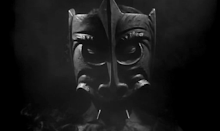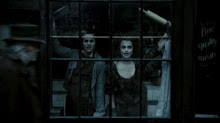Inevitable Plug: Son Of Danse Macabre, Bryce Wilson: That’s right folks I wrote a book this year and I’m still not tired of talking about it. Well I might be tired of talking about it, but I’m not tired of asking you to buy it.
Son Of Danse Macabre, is my personal history of the horror genre in the last thirty years (with some trips further back in time for foundation laying). I’ve been told by people I trust that it is readable. It’s 2.99 on the nook and kindle and every time some one gives it a shot, my Grinch heart grows three sizes that day.
Best Of Last Year: The Whore Of Akron, Scott Raab: Somehow I missed reading The Whore Of Akron until this year. Had I read it in time it would have been my favorite book of last year. Even if you don’t give two shits about American Basketball, The Whore Of Akron is an electrifying portrait of personal passion, despair, and what it means to be from somewhere. I felt every page in my gut. Thank you Scott Raab. Though the diaspora continues, one day we will have our victory. One day Cleveland Sports will be restored.
Dayenu.
Worst: Back To The Blood, Tom Wolfe: Tom Wolfe is dead. I have been waiting twelve years for the resurrection. I shant waste my time waiting any longer.
Most Disapointing: Kings Of Cool, Don Winslow: Coming from anybody else The Kings Of Cool would be perfectly acceptable, perhaps even good. But it’s not coming from anybody else, it’s coming from Don Winslow.
On one level I can’t really blame the guy, after all Universal was nice enough to buy a 50 million dollar marketing campaign for him, he’d be a fool not to take advantage of it. And Kings Of Cool has its moments, including a tormented monologue from one of the character's parents that almost makes it worth it. But no bright moment of passion, or turn of phrase can disguise the fact that Winslow’s heart just isn’t in it. That from the first page to the last Kings Of Cool is a book that has no damn reason to exist.
It’s the first Don Winslow book to feel anything other than essential. And that just hurts.
Who Gives A Damn If It's YA: The Fault In Our Stars: Yes The Fault In Our Stars may be written for Young Adults but its more acerbic, truthful, beautifully written and real, than most of what passes for contempary adult literature these days. One of those invaluable books where you suddenly find that you're not thinking of the characters as characters at all.
So why is is ghettoized if I truly don't give a damn whether it's "adult literature" or not? Because I shamefully forgot about it while making my outline and I don't feel like kicking any of the below books off the list. The shame is my own though not the books. Make time for it. You'll be glad, you did.
Who Gives A Damn If It's YA: The Fault In Our Stars: Yes The Fault In Our Stars may be written for Young Adults but its more acerbic, truthful, beautifully written and real, than most of what passes for contempary adult literature these days. One of those invaluable books where you suddenly find that you're not thinking of the characters as characters at all.
So why is is ghettoized if I truly don't give a damn whether it's "adult literature" or not? Because I shamefully forgot about it while making my outline and I don't feel like kicking any of the below books off the list. The shame is my own though not the books. Make time for it. You'll be glad, you did.
10 & 9 Some Remarks, Neal Stephenson, Distrust That Particular Flavor, William Gibson: I have commented before that it scare the shit out of me that both Neal Stephenson and William Gibson consider the modern day a suitable place to set their fiction. Now it seems they no longer even consider the fiction part necessary.
Both Some Remarks and Distrust That Particular Flavor bear the finger prints of their respective creators, two of our most dependable outliers. With Some Remarks a bit woollier containing everthing from a most unexpected defense of Zack Snyder’s 300, to a brief history of Fiber Optics (as well as a history of the various battles between the two authors, plasma swords are involved.) While Gibson is more precise and distant, trapping all his details in amber.
Both are invaluable looks at the world from the pleasure of their cracked prism.
8. The Croning, Laird Barron: The jump from the short story to the novel is a tricky transition for any author, but particularly the horror author who is charged with transplanting his work from his genre’s natural habitat to much more inhospitable soil.
Fortunately with his first novel Laird Barron proves himself one of the authors capable of making the jump. Delivering a book with the same sense of shuddering decay that his best short work offers. Barron does, “cheat” a little bit, layering his book with short stories in the best Neil Gaiman puzzle box fashion. But as The Croning builds to its final awful whole, one cannot help but reflect that whatevee the format Barron is awful damn good.
7. Gone Girl, Gillian Flynn: “I’d hate to take a bite of you. You’re a cookie full of arsenic.”
It is one thing to have a book be extraordinarily popular and critically acclaimed. It is another thing to have a book be extra ordinarily popular and acclaimed and also be really, really good. Come on Gillian Flynn what are you trying to do? Break my spirit?
And make no mistake Gone Girl is really, really good. The prose is of a “Why do I bother” quality, combined with a twisted gift for plotting, and an acerbic misanthropic world view. Patricia Highsmith would spit with envy.
6. Sacre Blue, Chris Moore: Those expecting the usual Christopher Moore maniac farce might walk away from Sacre Blue a bit disappointed. Sure, there are the usual pleasures of Moore at full bear. The word play, the bad behavior, donkeys, decapitations (sorry accident, couldn’t be helped) the unusually kind heart and of course the sex. But it is an unusually somber Moore who shows up and delivers an unexpectedly weighty and moving consideration of the burdens and prices of producing art. (Imagining Moore peaking over my shoulder I can’t help but picture him saying, “Yes and the dick jokes, don’t forget those. There are some good ones in there.”)
There are some good ones in there, but there’s also a true sense of melancholy. The price the muse demands can at times be even worse than syphilis (though she has a fondness for that one) and Moore writes of it with sympathy, and a conviction that it is worth it. It’s also a book where you can read about Toulouse LauTrec battling an immortal cave man. So you know, good times.
5. Redshirts, John Scalzi: Like Sacre Blue Scalzi presents what only looks like a weightless farce. The idea is irresitable, a crew of expendable one shot characters realize the nature of their plight. But for all the genre callbacks and Cabin In The Woods style, post modern shenanigans, what really gives Redshirts its depth is the frank examination of what we give to the things we create and what they give back. There is an awful lot in its much maligned three part ending about the nature of storytelling. Many complained about the sudden swerve, but it changes Redshirts from something clever, but necessarily shallow, to a truly substantial work of fiction.
4. The Twelve, Justin Cronin: I have figured out that I should just stop trying to figure out what Justin Cronin is trying to do.
The Passage left me stumbling and grasping every hundred pages or so, and The Twelve follows neatly in its footsteps, ignoring the clear narrative set up of the closing pages of The Passage in favor of a story that finds its central characters stuck in inertia while the world ends around them.
But the pleasures of Cronin’s world and story are, well not secondary, but rather a support system for what Cronin is able to convey with them. Elsewhere I have ventured that if it is the purpose of literary fiction to break the icy seas within ourselves, then perhaps it is genre fictions job to simply make us a little braver. With his story of courage in the face of loss and oblivion, I believe Cronin has accomplished just that. Writing an unforgettable cast of characters who are defined by the fact that when given a second chance, a chance to be better than they are, they more often rise to the occasion than not. In the books key segement a character responds to an unanswerable question with the words, “I could have held his hand.” The moment he gets the opportunity to do just that is the most moving I’ve come across in fiction in quite awhile.
And that is the reason that for all its dark imagery, and operatic bleakness Cronin’s devasted world is one of profound optimism. The Zero may seek to end all things, but he won’t do it without a fight.
3. Telegraph Avenue, Michael Chabon: What can be said of Chabon’s novel. It possesses the kind of messy exuberance that Wolfe once had, before he, you know, died. But there is a warmth here that Wolfe never had, even at his most admiring. Like the area it documents Telegraph Avenue has the sprawling messiness of life, in the way that Chabon’s slightly neat hermetic work never really had. It suits him
2. Live By Night, Dennis Lehane: Or as I like to think of it, Damn It Feels Good To Be A Gangster. While Live By Night's predecessor, The Given Day somewhat buckled under the weight of its admirable literary aspirations, Live By Night is a lean work of glorious pure pulp the type that Lehane hasn’t delivered since Sacred. Rough, propulsive, and with Lehane’s trade mark economical weighty prose Live By Night was a kick to my particular set of literary pleasure receptors, with a directness that almost seems unfair to the other books on the list.
1. This Book Is Full Of Spiders, David Wong: There is no more dangerous activity than trying to catch lightning in a bottle a second time. And make no mistake, John Dies At The End was lightning in a bottle. Everything from its piecemeal creation, to its novella structure, conspired to make it something completely unexpected. On this level This Book Is Full Of Spiders faced a near impossible task. By its very definition the reader had expectations for it.
So all credit to Jason Pargin (ie David Wong) who managed to find the improbable juke. Delivering a novel deeper, richer, scarier, funnier and on every level better than John. The growth that Pargin shows between the two books is staggering. It’s not every book that can scare the shit out of you, make you laugh, consider how deeply fucked we as a species might be and leave the reader with a resilient kernel of optimism all the same; all in the space of five pages. In short This Book Is Full Of Spiders delivers everything I ask from literature and it does it again and again and again.

































































































































